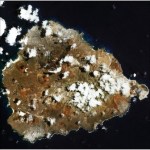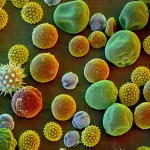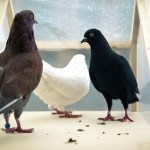iGEM
Changing our energy infrastructure from one that contributes to climate change to one that is renewable and sustainable poses enormous challenges technically, politically, socially, and economically. There isn't going to be a single solution, but a combination of technological changes, policy changes, efficiency gains, and adaptations to local environments will likely go a long way to making our current system better.
But there is a big difference between better and good. In Cradle to Cradle: Remaking the Way We Make Things, architect Bill McDonough and environmental chemist Michael…
Synthetic biologists work on designing living cells, but engineered bacteria don't usually come up when you think of "designer" things. This year however, a synthetic biology design is up for a Brit Insurance Design of the Year award, up against the Lanvin Spring collection, Angry Birds, and Rock Band 3! Designers Daisy Ginsberg and James King worked in collaboration with the 2009 Cambridge iGEM team (including awesome blogger Lab Rat) to imagine ways that people could use bacteria engineered to produce pigments in the future. Check out their video about the science and design of E. chromi:
It's been a few weeks since the iGEM jamboree, a whirlwind, completely exhausting weekend of student synthetic biology projects. This tweet from Robin Sloan from the #igem2010 stream is a pretty good way to sum up the weekend:
.bbpBox987719207489536 {background:url(http://a3.twimg.com/profile_background_images/3386569/giant2.jpg) #777f88;padding:20px;} p.bbpTweet{background:#fff;padding:10px 12px 10px 12px;margin:0;min-height:48px;color:#000;font-size:18px !important;line-height:22px;-moz-border-radius:5px;-webkit-border-radius:5px} p.bbpTweet span.metadata{display:block;width:100%;clear:…
This is just awesome:
A strain of Escherichia coli bacteria can now solve [sudoku] puzzles
[...]
"Because sudoku has simple rules, we felt that maybe bacteria could solve it for us, as long as we designed a circuit for them to follow," says team leader Ryo Taniuchi.
The mechanism is ingenious and yet straightforward at the same time.
Basically, they have 16 different strains of bacteria, with each initial strain representing a spatial coordinate on a 4x4 grid. Each bacterium has a "4C3 leak" system, which is a chunk of DNA that the team designed that has 4 possible outputs. Depending on…
iGEM students are nothing if not creative, fun, and super nerdy. Here is a taste of some of the awesome videos being made by this year's crop, enjoy!
Cambridge, with a catchy song about new techniques for joining pieces of DNA together:
(via LabRat)
Hong Kong University's Inception trailer:
TU Delft, finding science in pop music:
And of course, Harvard, being dramatic in the lab:
There's a neat article in the Guardian today about designing new foods with genetic engineering and biotechnology.
Food, science, and design are intertwined from how we grow our food to how we eat it, from microwavable dinners to three-star molecular gastronomy at El Bulli. Designers like Oron Catts and James King who explore the possible future of synthetic biology and biotechnology present new ways of thinking about producing and shaping new foods like in vitro meat.
Although the work of designers such as Catts and King is speculative, it raises interesting questions about the future role…
This year's Cambridge iGEM team has made a tiny, wireless lightbulb filled with bioluminescent bacteria! There are two main ways of engineering luminescence in E. coli (I assume these are E. coli, correct me if I'm wrong!). One is to express the luciferase gene from fireflies, which adds ATP and oxygen to the chemical luciferin, producing oxyluciferin and yellow, green, or red light.
Since the lightbulb is blue, this bacteria is probably expressing the Lux operon from Vibrio fischeri, which use their bioluminescence in an awesome underwater symbiosis. From the Cambridge iGEM wiki:
Some…
Life transforms environments, creating ecosystems where there was once only rocks. The evolution of photosynthetic bacteria billions of years ago created the atmosphere we have today, paving the way for the evolution of larger, oxygen-breathing organisms. We humans obviously transform our environment in countless ways, but can we also engineer barren environments to be hospitable to life? Can we create new living, self-sustaining ecosystems in hostile places? Can we turn lifeless planets into second Earths through the clever introduction of life forms?
Terraforming is the (currently…
Sometimes among all of the tedious protocols and mundane inconclusive data, I forget that I'm doing something amazing and incredibly powerful. Almost all my experiments require altering a living organism to do my bidding--to hold onto and replicate a piece of DNA that I'm interested in or to produce an enzyme that I want a lot of. Thanks to iGEM this summer I've gotten to learn some new soon-to-be-tedious protocols that seem absolutely thrilling now, and the experience is reminding me of how awesome (in the real sense of the word) genetic engineering is.
The team is working with the model…
A recent survey of 3,000 people worldwide found what many have known all along--that Legos are the best toy ever made. For synthetic biologists, this doesn't come as much of a surprise--Legos are at the heart of the concepts underlying the basics of synthetic biology.
Legos are a favorite analogy for BioBricks, the DNA parts that are made to easily "snap" together using a shared genetic engineering strategy. The iGEM competition is structured around BioBricks, with undergraduate teams combining old and creating new BioBricks for the Registry of Standard Biological Parts, competing for the…
It turns out that my wonderful iGEM students, besides being brilliant scientists, are also excellent, hilarious actors. Please enjoy their Jersey Shore inspired video about molecular cloning:
I recently found this fascinating (relatively) old review article (open access) by awesome MIT professor Natalie Kuldell about teaching synthetic biology. Synthetic biology has integrated teaching and learning with the development of the field since basically the beginning of the field, with students contributing to new technologies through iGEM and academic lab-based courses. By actively participating in a new field students get a unique educational experience, and the field benefits through the work of students being trained as engineers and biologists:
Synthetic biology, with its inclusive…
Check out these iGEM twitter pages to follow the antics of iGEM teams around the world this summer (and let me know if I missed any teams)!
iGEM headquarters @igem
Biotec Dresden @igem_biotec
Bielefeld @iGEM_Bielefeld
Brazil @igembrasil
Calgary @iGEMCalgary
Cambridge @camgem
Canada @igemcanada
Chiba @Chiba_iGEM2010
Debrecen @debrecenigem
DTU @igemdtu2010
Edinburgh @IlluminatiED
EPFLausanne @IGEM_EPFL
Freiburg @FreiburgBioware
Georgia State @iGEMGSU
Georgia Tech @georgiatechigem
Groningen @igemgroningen
Harvard @harvardigem
IIT Delhi @iitdelhiigem
Imperial @imperialigem
Illinois Software @…
The first (and sometimes 3rd, 12th, 25th, 134th...) step of any genetic engineering experiment is often extracting DNA from some organism or another. While novel gene synthesis technology will likely make this procedure obsolete, these days it's still most economical to do it by hand. Extracting DNA from fruits like strawberries has also seen a popular resurgence thanks to groups like DIYbio, with instructions for making DNA shots available online for a fun and nerdy party activity. Today my iGEM team extracted RNA from strawberries and oranges to isolate the genes responsible for strawberry…
iGEM officially starts for the Harvard team tomorrow for some good old-fashioned fun with BioBricks, arabidopsis, protein-based sweeteners, and shRNA! Our goal is to make a system for genetically engineering plants safely and easily with some hopefully fun and useful applications in the short term. iGEM (the International Genetically Engineered Machines competition) is about fun and open science, so we hope you enjoy following along with our adventure on our wiki, blog, twitter, or even become a fan on facebook. As a proud teaching fellow I'll be posting updates here periodically all summer,…
I don't get nearly as many emails asking for advice as I'm sure the lovely and talented Dr. Isis does, and I'm not sure if my advice can compare in quality and sassiness to hers, but I want to address the questions I get most often--how do you get into synthetic biology if your background is in something else, and how do you get into a PhD in synthetic biology?
While there are an increasing number of labs that work primarily on synthetic biology and schools with undergraduate iGEM teams, there are still very few (if any?) graduate programs that will write "Synthetic Biology" on your diploma,…
A recent New York Times article tells us that what many people call food allergies are actually simple intolerances, and that allergies are being dangerously overdiagnosed. What is a true food allergy, and what can be done to fix them besides banning peanuts from schools and avoiding foods that make us itchy?
Allergies are caused by an inappropriate immune response to common things in the environment. Usually the offending allergen is a protein that comes from plants or animals like pollen or dander. Instead of the immune system recognizing that these proteins are harmless, it instead…
I've been co-teaching a short class on synthetic biology this spring through the MIT High School Studies Program (HSSP). The program is awesome, I took classes through a similar MIT program as a nerdy middle schooler and have had a great time teaching the past few weeks (if you're in the Boston area I highly recommend checking it out as a student or as a volunteer teacher!). My students were terrific--smart, open to new and crazy ideas, thoughtful about bioethics issues, and enthusiastic about thinking about what biology can do and designing new biological species.
Today was our last day of…
I'm a little late in posting about the recent work of Tuur Van Balen, a Belgian designer who uses art and design to explore the boundaries between people and technology. His work has explored synthetic biology and biotechnology for years, and I first was introduced to his work through news of his Urban Biogeography project. A recent focus in synthetic biology has been the design of simple biosensors, strains of bacteria or yeast that can sense an environmental pollutant and produce a measurable output such as color change. Thanks to the work of several very creative iGEM teams, the Registry…
Light interacts with and controls biological systems in diverse and fascinating ways. Our eyes are made up of thousands of cells that respond to light, sending signals to our brain as light in different colors and shapes moves across them. Photosynthetic cells are full of receptors that can sense and respond to many wavelengths of light, allowing cells to absorb light for photosynthesis, but also to move towards areas of more sunlight and know when the seasons are changing. Synthetic biology takes these light-responsive systems as parts that can be recombined, shuffled and integrated into…












